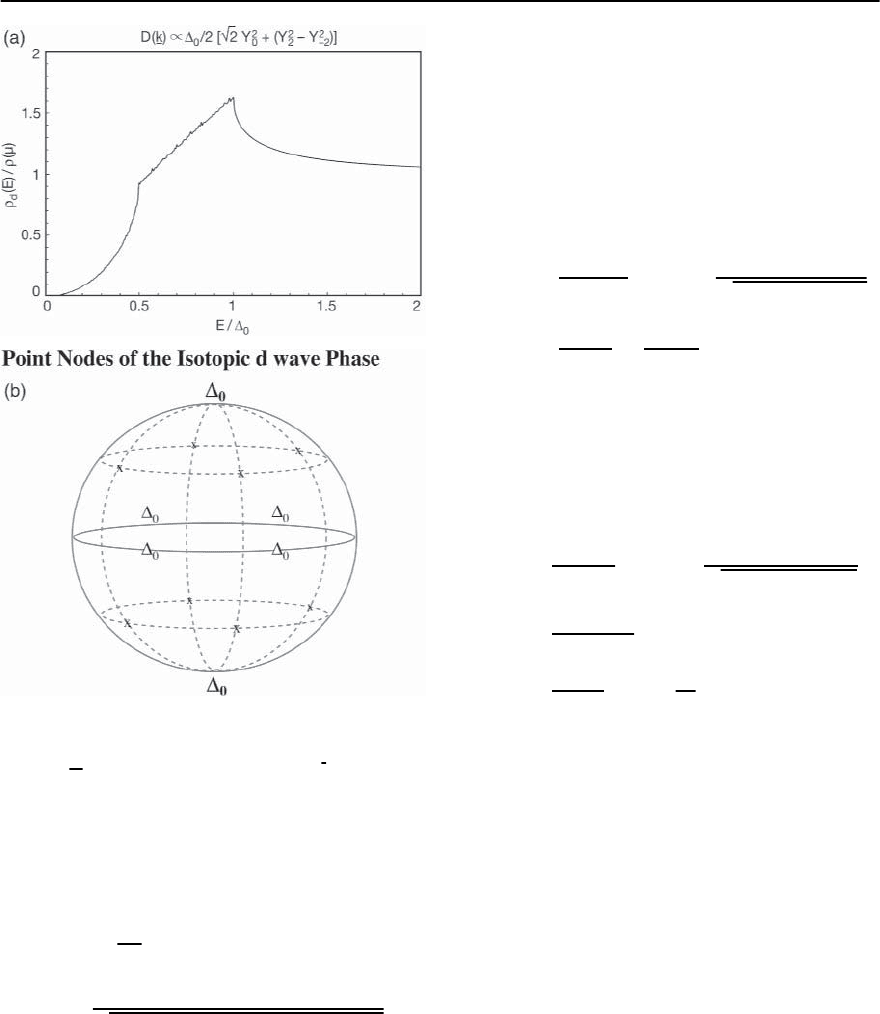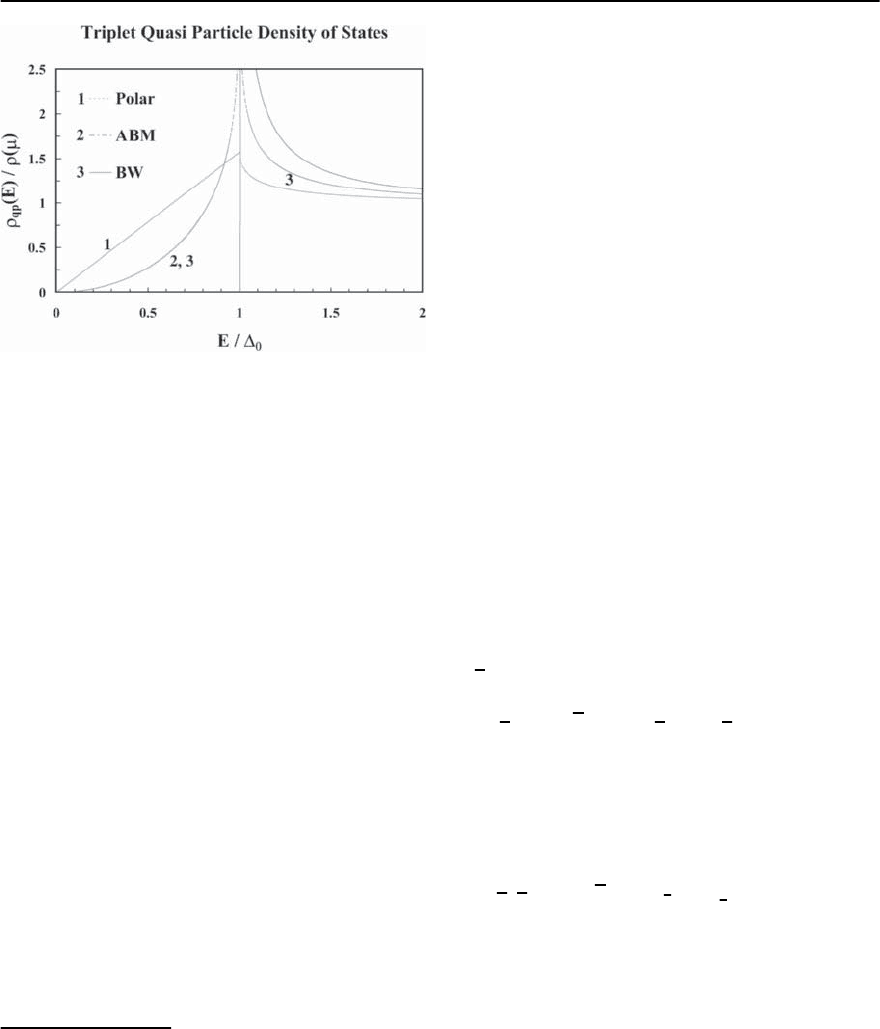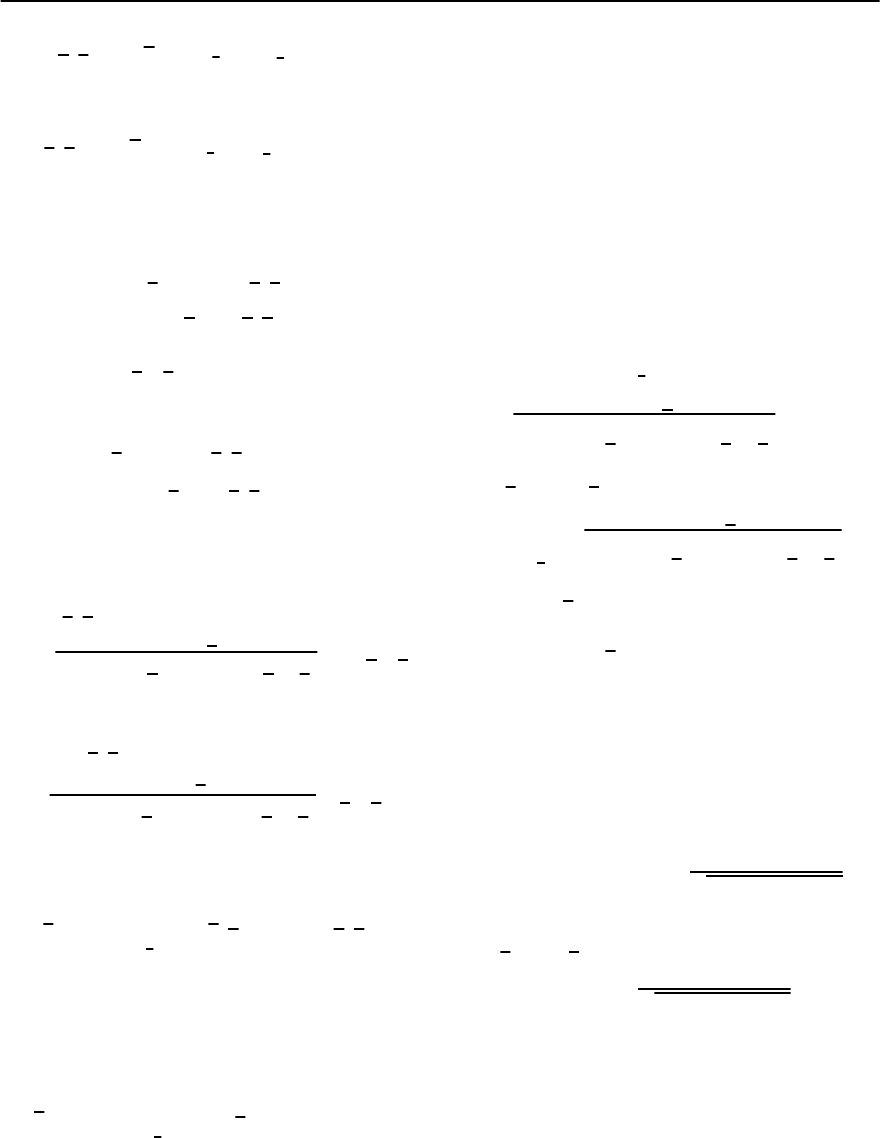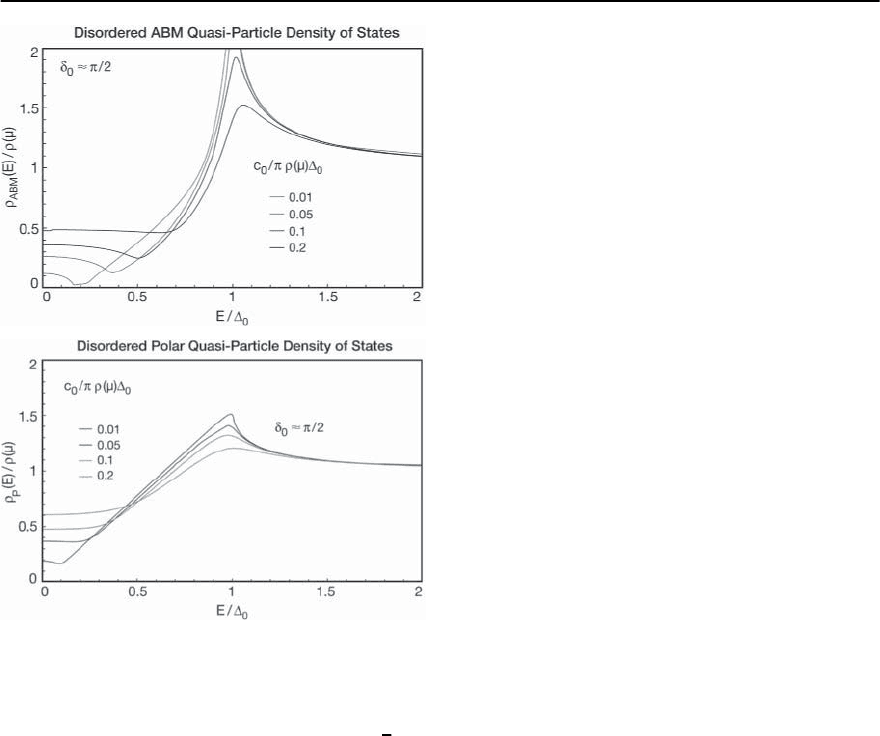Bennemann K.H., Ketterson J.B. Superconductivity: Volume 1: Conventional and Unconventional Superconductors; Volume 2: Novel Superconductors
Подождите немного. Документ загружается.


1060 P.S. Riseborough,G.M. Schmiedeshoff,and J.L.Smith
Table 19.4. Singlet pairing basis functions in the tetragonal
D
4h
group
Representation Basis Functions
+
1
(A
1g
)1
+
2
(A
2g
) k
y
k
x
(k
2
x
− k
2
y
)
+
3
(B
1g
) k
2
x
− k
2
y
+
4
(B
2g
) k
x
k
y
+
5
(E
g
) k
z
k
x
; k
z
k
y
, k
z
k
3
x
; k
z
k
3
y
Table 19.5. Triplet pairing basis functions in the tetragonal
D
4h
group. The value k
x
± ik
y
is denoted by k
±
and the
vector ˆx ± iˆy is denoted by ˆr
±
. The upper and lower signs
± in the doubly degenerate E
u
representation correspond
to the degenerate partners (n =0;2)
Representation Basis Functions
−
1
(A
1u
) ˆzk
z
; Reˆr
−
k
+
; Reˆr
+
k
3
+
−
2
(A
2u
) Imˆr
−
k
+
; Imˆr
+
k
3
+
; ˆzk
z
Imk
4
+
−
3
(B
1u
) ˆzk
z
Rek
2
+
; Reˆr
+
k
+
; Reˆr
−
k
3
+
−
4
(B
2u
) ˆzk
z
Imk
2
+
; Imˆr
+
k
+
; Imˆr
−
k
3
+
−
5
(E
u
) ˆzk
n+1
±
; k
z
ˆr
±
k
n
±
; k
z
ˆr
±
k
n+2
∓
Table 19.6. Singlet pairing basis functions in the hexagonal
D
6h
group. The value k
x
± ik
y
is denoted by k
±
. The upper
and lower signs ±in the doubly degenerate E
g
representa-
tions correspond to the degenerate partners.
Representation Basis Functions
+
1
(A
1g
)1
+
2
(A
2g
) Imk
6
+
+
3
(B
1g
) k
z
Imk
3
+
+
4
(B
2g
) k
z
Rek
3
+
+
5
(E
1g
) k
z
k
±
; k
z
k
5
∓
+
6
(E
2g
) k
2
±
; k
4
∓
to the order parameter vanishing on the four lines
k
x
= ±k
y
= ±k
z
, which intersect the Fermi surface
in eight points, resulting in eight point nodes.
The detailed node structure of degenerate rep-
resentations depends on the spontaneous symmetry
breaking between the degeneratepartners.In the sin-
glet case, the phase of the order parameter D(k
)can
always be chosen to be zero and so D(k
), if it van-
ishes, does so on surfaces that intersect the Fermi
surface in curves. Examples of this are found in both
the triply degenerate O
h
+
5
(T
2g
)andthedoublyde-
Table 19.7. Triplet pairing basis functions in the hexago-
nal D
6h
group. The value k
x
± ik
y
is denoted by k
±
and
the vector ˆx ± i ˆy is denoted by ˆr
±
.TheRe and Im terms
in the doubly degenerate E
u
representations correspond to
the degenerate partners
Representation Basis Functions
−
1
(A
1u
) ˆzk
z
; Re ˆr
+
k
−
; Re ˆr
+
k
5
+
−
2
(A
2u
) Imˆr
+
k
−
; Im ˆr
+
k
5
+
; Imˆzk
z
k
6
−
−
3
(B
1u
) Imˆzk
3
−
; Imˆr
+
k
z
k
2
+
; Imˆr
+
k
z
k
4
−
−
4
(B
2u
) Reˆzk
3
−
; Reˆr
+
k
z
k
2
+
; Reˆr
+
k
z
k
4
−
−
5
(E
1u
) Re ˆzk
+
; Reˆr
+
k
z
; Reˆr
−
k
z
k
2
+
;
Re ˆzk
5
−
; Reˆr
−
k
z
k
4
−
; Re ˆr
+
k
z
k
6
−
,
Imˆzk
+
; Imˆr
+
k
z
; Imˆr
−
k
z
k
2
+
;
Im ˆzk
5
−
; Imˆr
−
k
z
k
4
−
; Im ˆr
+
k
z
k
6
−
−
6
(E
2u
) Reˆr
+
k
+
; Reˆzk
z
k
2
+
; Reˆr
−
k
3
+
;
Reˆr
−
k
3
−
; Reˆr
+
k
5
−
; Reˆzk
z
k
4
−
,
Imˆr
+
k
+
; Imˆzk
z
k
2
+
; Imˆr
−
k
3
+
;
Imˆr
−
k
3
−
; Imˆr
+
k
5
−
; Imˆzk
z
k
4
−
generate
+
3
(E
g
) singlet pairing representations. It is
seen that if the system spontaneously selects any one
of the degenerate partners, the order parameter will
vanish on two distinct planes leading to two lines of
nodes. Also, if the effects of the higher order angu-
lar momentum contributions are minimal, an arbi-
trary linear combinationof degenerate partner basis
functions also makes the order parameter vanish on
two surfaces leading to two curved lines of nodes.
The analogous case for the singlet D
4h
symmetry is
given by the doubly degenerate
+
5
(E
g
)representa-
tion, which also can yield lines of nodes. One of the
line nodes is the intersection of the plane k
z
=0with
the Fermi surface.
With triplet pairing,the phase of the order param-
eter can also be chosen to be real in the unitary case.
However, in this case, due to the stringent require-
ment that if
−→
d (k
) is to vanish, three equations to
be satisfied, the only nodes which occur usually are
point nodes. These may be satisfied by symmetry, as
in the tetragonal
−
2
(A
2u
) pairing shown in Table 19.5
where, if f
2
= f
3
= 0, symmetry dictates that the
order parameter vanishes on the line k
x
= k
y
=0.In
this case, the gap that develops on the Fermi surface
has isolated nodes at the poles.
However, line nodes also can be obtained for
triplet phases. As Blount has noted [141], the van-

19 Heavy-Fermion Superconductivity 1061
ishing of the order parameter on a surface can be
achieved since the rotational invariancein spin space
can reduce the number of independent components
of
−→
d to two and thus lead to a line of nodes on
the Fermi surface. An example of this is given in the
O
h
groupwiththe
−
3
(E
u
) irreducible representation
where, if
−→
d spontaneously chooses to lie in the k
direction, then
−→
d (k) vanishes on two surfaces and
leads to two lines of nodes on the Fermi surface.This
type of situation is expected to be forbidden when
the effect of spin-orbit couplingis taken into consid-
eration. The irreducible representations for singlet
and triplet pairings of the hexagonal group D
6h
are
shown in Tables 19.6 and 19.7.
In addition to the point group symmetry, the su-
perconducting order parameter must also have the
same translational symmetry as the lattice. In par-
ticular, the order parameter must be periodic in
the Brillouin zone and should also reflect any other
translation symmetry element present in the space
group. The functions given in the tables correspond
to the longwavelengthlimit formof theorderparam-
eters. Some possible forms of the order parameters
with the correct translational symmetry have been
examined for the case of UPt
3
[148,149].
Spin-Orbit Coup ling
In the presence of spin-orbit coupling, the electrons
spin quantized about any fixed axis is no longer a
good quantum number, however, the electron does
have a well defined magnetic moment.The magnetic
moment is an axial vector and can be expressed in
terms of a k
dependent gyromagnetic ratio g
i,j
which
couples to the electron spins via
m
i
(k)=
1
2
j
g
i,j
(k)
j
. (19.71)
Then, in second quantized form, the magnetic mo-
ment operator is given by the expression
ˆ
−→
M(k
)=
1
2
˛,ˇ
a
†
˛
(k)
−→
m(k)
˛,ˇ
a
ˇ
(k) (19.72)
The expectation value of this operator can be ex-
pressed in terms of the one-electron density matrix
˛,ˇ
(k)=< |a
†
˛
(k)a
ˇ
(k)| >,as
< |
ˆ
−→
M(k
)| >= Trace
−→
m(k)(k)
. (19.73)
Since the Zeeman splitting of the electron in a Bloch
state k
is given by the eigenvalues, ± E
z
(k), of the
Hamiltonian
H
Z
=−
−→
M(k).
−→
H . (19.74)
Then the splitting of the eigenvalues is found from
H
2
Z
independent of the choice of basis. As the Hamil-
tonian is a Hermitian operator, the eigenvalues are
found in terms of the g factorsas
E
Z
(k)
2
=
1
4
−→
H . ˜g(k
)
t
˜g(k) .
−→
H . (19.75)
This shows that, even though the spin is not a good
quantum number, the pairing states can be deter-
mined in terms of a quasi-spin, independent of the
basis, as had been assumed by Anderson [145]. The
order parameter still takes on the same form in that it
is still composed of either a scalar or a scalar product
of an axial vector with
−→
m(k
)
˛,ˇ
(k)=
D(k)+
−→
d (k) .
−→
m(k)
(i
y
)
˛,ˇ
.
(19.76)
The results derived in the presence of spin-orbit cou-
pling go smoothly over into the zero spin-orbit case,
as can be seen by expressing the order parameter in
the form
†
(k) (k)=
D(k)
2
+
−→
m(k) .
−→
d (k)
−→
d
∗
(k) .
−→
m(k)
.
(19.77)
With the use of the Pauli identity, this procedure
yields the same expression for the quasi-particle
eigenvalues as Eq. (19.60), but in which
−→
d (k
)is
merely replaced by
−→
d (k
) g(k). Thus, most of the for-
mal results for the superconducting quasi-particles
found without spin-orbit coupling also hold when it

1062 P.S. Riseborough,G.M. Schmiedeshoff,and J.L.Smith
is present. In particular, one expects that the charac-
teristic energy dependence of the superconducting
quasi-particle density of states will be unaffected by
spin-orbit scattering.
Quasi-Particle Density of States
The density of states for single quasi-particle exci-
tations for anisotropic superconducting states have
distinctly different forms which are determined by
whether the gap is nodeless, has isolated nodes, or
lines of nodes and also the slope with which the
gap falls to zero. The quasi-particle density of states
qp
(E)isgivenby
qp
(E)=
1
2
k,±
ı(E ± E
,k
) . (19.78)
On assuming singlet s-wave pairing, one finds the
BCS result
BCS
(E)=()
|E|
E
2
− |
0
|
2
(19.79)
for |E | >
0
,otherwise
BCS
(E)=0.Here()isthe
normal phase density of states thathas been assumed
to be constant near the Fermi energy and D(k
F
)=
0
.
Since this s-wave phase shows a gap of width 2|
0
|
all the way around the position of the normal state
Fermi surface, a number of physical quantities show
simple exponentially activated behavior in the low
temperature regime where the temperature depen-
dence of the superconducting gap is small. For the
anisotropicsingletd
x
2
−y
2
pairing,thedensity of states
is given by
d
x
2
−y
2
(E)=
()|E|
4
2
0
d
0
d (19.80)
×
sin
E
2
− |
0
|
2
sin
4
cos
2
2
.
As the order parameter vanishes on two great circles,
cos 2 = 0,ontheFermisurface,thedensityofstates
is proportional to E ln E as E/
0
→ 0. The d
2z
2
−x
2
−y
2
Fig. 19.22. The quasi-particle density of states
qp
(E)for
selected singlet superconducting phases, in the clean limit.
The BCS s-wave state has a true gap in the quasi-particle
density of states, and a singularity at the gap edge. The
maximum superconducting gap is denoted by
0
.Thed-
wave phases have states with energies below
0
order parameter of a cubic material also hastwo lines
of nodes, which results in the density of states
d
2z
2
−x
2
−y
2
(E)=
()|E|
2
0
d (19.81)
×
sin
E
2
−
1
4
|
0
|
2
(1 − 3 cos
2
)
2
that also tends to zero linearly for small E.Thequasi-
particle density of states for these particular singlet
phases are shown in Fig. 19.22. The quasi-particle
density of states for the phases d
x,y
, d
x,z
and d
y,z
should be identical with
d
x
2
−y
2
(E).Foranisotropic
system, the most stable d-wave phase [130] corre-
sponds to a linear combination of the even m order
parameters
D(
ˆ
k) ∝
1
√
2
Y
2
0
(
ˆ
k)+
1
2
(Y
2
2
(
ˆ
k)−Y
2
−2
(
ˆ
k))
, (19.82)
which only has point nodes. Therefore, the quasi-
particle density of states varies as E
2
for small E,as
shown in Fig. 19.23.
For triplet pairing, the differing node structures
yield different forms for the quasi-particle density
of states.The density of states is given in terms of an
integration over the direction of k
,

19 Heavy-Fermion Superconductivity 1063
Fig. 19.23. (a) The quasi-particle density of states
d
(E)
for an isotropic d-wave phase, with the order parameter
|D(
ˆ
k)| =
0
2
[(3 cos
2
−1)
2
+3sin
2
2' sin
4
]
1
2
.Sincetheor-
der parameter has eight point nodes as the quasi-particle
density of states is proportional to E
2
for small E.Also,
since the order parameter only attains its maximum value
of
0
at six isolated points, the density of states does not
diverge, (b) Nodes of O.P.
S=1
(E)=
1
8
()
d§
Re (19.83)
×
|E|
E
2
+ |
−→
d (
ˆ
k)|
2
− |i
−→
d (
ˆ
k) ∧
−→
d
∗
(
ˆ
k)|
.
We shall describe the relation between the order pa-
rameter and the quasi-particle density of states for
the well known p-wave states. The BW state, having
an isotropic gap and no nodes, has the same density
of states as the singlet s-wave phase given by the BCS
expression,but where
0
isgiven by themagnitude of
−→
d at the position of the normal state Fermi surface.
The ABM state order parameter given in spherical
polar coordinates is
−→
d = ˆz
0
sin e
i
, and so the
quasi-particle density of states in the ABM phase is
found from
ABM
(E)=
() |E|
4
2
0
d
0
d
sin
E
2
− |
0
|
2
sin
2
=
()E
2
0
ln
E +
0
E −
0
. (19.84)
Thus, the density of states in the ABM phase has a
weak logarithmic singularity at E =
0
and falls to
zero as E → 0likeE
2
, due to the presence of iso-
lated nodes. In the polar state,
−→
d = ˆz
0
cos ,sothe
density of states is given by
p
z
(E)=
()|E|
4
2
0
d
0
d
sin
E
2
− |
0
|
2
cos
2
=
()|E|
2
0
0
> |E|
=
()E
0
arcsin
0
E
0
< |E| . (19.85)
Thus,due tothe presence of a line of nodes in the po-
lar phase,the quasi-particle density of states at lower
energies onlyfallsto zero linearly in E,asE → 0.This
should be contrasted with the ABM phase, which has
isolated point nodes where the density of states goes
to zero quadratically with E. The larger density of
states at low energies for polar phase with its line
nodes compared with the ABM phase with its point
nodes, is compensated by the decrease in the peak of
the quasi-particle density of states. That is, the polar
state only shows a slight enhancement at
0
where
the density of states only has a cusp, but the ABM
state shows a divergence. The quasi-particle density
of states for the singlet BCS state is shown together
with the d
2z
2
−x
2
−y
2
state and the d
x
2
−y
2
in Fig. 19.22.
Thesingularitiesandcuspsareduetothegapshav-
ingextremalpointsat thepositionof the normal state

1064 P.S. Riseborough,G.M. Schmiedeshoff,and J.L.Smith
Fig. 19.24. The quasi-particle density of states
qp
(E)for
selected triplet p-wave superconducting states,in the clean
limit. The density of states of the BW phase is identical
to that of the BCS s-wave phase. The ABM phase and polar
phases havestates below
0
.TheABM or axial state shows a
quadratic energy dependence for energies below
0
,while
the polar state has a linear energy dependence
Fermi surface.The quasi-particledensity ofstates for
the triplet BW, ABM, and polar states are shown in
Fig. 19.24. The low-energy behavior of these quasi-
particle density of states are quite distinct, having
different power law dependences in E. The different
power laws are due to the differences in the node
structure of the superconducting gap. These power
law dependences may be expected to show up in ther-
modynamic properties far below T
c
, albeit modified
by the effects of impurity scattering and collective
excitations.
Pair Breaking Impurities
In an s-wave superconductor, the effect of non-
magnetic impuritiesis minimal
6
and results in a pair
weakening effect, which can be absorbed into a re-
duction of the pairing potential or density of states.
Anderson’s theorem [151],whichdescribes the effect
of non-magnetic impurities in s-wave superconduc-
tors, can be stated as,“A static external perturbation,
that neither breaks time reversal invariance nor pro-
duces a spatial variation of the order parameter,does
not produce a change in the thermodynamic proper-
ties of a superconductor.”Since the order parameters
of anisotropic superconductors are inhomogeneous,
Anderson’s theorem no longer applies and the effect
of impurities is analogous to that of magnetic impu-
ritiesin s-wave superconductors[152,153].Theanal-
ogy is complete in that significant concentrations of
impurities may produce significant changes in the
low-energy density of states leading to the removal of
any remaining gaps. The changes in the low-energy
variation of the quasi-particle density of states lead
to variances in the power law temperature depen-
dences expected from analysis of the simple node
structures of clean materials [154–156].
The types of effect caused by non-magnetic im-
purities in anisotropic superconductors can be seen
by examining the density of states in the supercon-
ducting state in which the impurity potential, U
0
,is
short-ranged and is treated as a small perturbation.
The density of states can be obtained from the trace
of the Green’s function in the superconducting state.
To treat the pairing in the superconducting state,one
introduces the four by four matrix Green’s function
G(k
; ) describing the four component fields, via
G(k
; )=−
1
< |
ˆ
T¦ (k
, )¦
†
(k, 0)| >, (19.86)
where
ˆ
T is Wick’s time ordering operator.The upper
and lower two by two diagonal blocks have matrix
elements that are related to the usual Green’s func-
tions
G
˛,ˇ
(k, k
; )=−
1
< |
ˆ
Ta
k,˛
()a
†
k
,ˇ
(0)| >.(19.87)
The upper and lower two by two off-diagonal blocks
represent the anomalous Green’s functions, as intro-
duced by Gor’kov [157].The elements of the anoma-
lous Green’s functions are written as
6
The variation of T
c
for Sn with a concentration of In impurities was studied by Coles [150]. The T
c
showed a sharp
initial drop which saturated for In concentrations of about 2%. The initial drop of T
c
is attributed to the impurities
destroying the anisotropy of the Fermi surface. This is not a violation of Anderson’s theorem since it strictly only
applies to systems with isotropic Fermi surfaces. The almost constant value of T
c
which is found for In concentrations
greater than 2% is a verification of Anderson’s theorem.

19 Heavy-Fermion Superconductivity 1065
F
˛,ˇ
(k, k
; )=
1
< |
ˆ
Ta
k,˛
()a
−k
,ˇ
(0)| > (19.88)
and
F
†
˛,ˇ
(k, k
; )=
1
< |
ˆ
Ta
†
−k
,˛
()a
†
k
,ˇ
(0)| >. (19.89)
Within the mean-field approximation, the Fourier
transform of the Green’s functions are given by the
solutions of the coupled equations
(i !
n
− e(k)+)G
˛,ˇ
(k, k
; i!
n
)
+
˛,
(k)F
†
,ˇ
(k, k
; i!
n
) (19.90)
= ı
˛,ˇ
ı(k − k
)
and
(i !
n
+ e(k)−)F
†
˛,ˇ
(k, k
; i!
n
) (19.91)
+
∗
˛,
(k)G
,ˇ
(k, k
; i!
n
)=0.
In the unitary states, these equations have the solu-
tion,
G
˛,ˇ
(k, k
; i!
n
) = (19.92)
−
( i !
n
+ e(k)−)
2
!
2
n
+(e(k)−)
2
+
†
(k)(k)
ı
˛ˇ
ı(k − k
)
and
F
†
˛,ˇ
(k, k
; i!
n
) = (19.93)
+
∗
˛,ˇ
(k)
2
!
2
n
+(e(k)− )
2
+
†
(k)(k)
ı(k
− k
) .
The order parameter is determined from the non-
linear equation
˛,ˇ
(k)=−k
B
T
n,q
,
V(k, q)
ˇ,˛;,
F
,
(q, q; i!
n
),
(19.94)
which yields as a function of temperature. We as-
sume a low concentration of impurities, c
0
,thatare
randomly distributedand act as point scatterers.The
matrix self-energy can be calculated as
£(k
; i!
n
)=c
0
p
U
0
4
G(p; i!
n
)
4
U
0
, (19.95)
where
4
is the 4 × 4 Dirac matrix that is written in
block diagonal form as
4
=
I 0
0−I
. (19.96)
Here, I is the unit two-by-two matrix. The Green’s
functions have to be calculated self-consistently. In
the unitary case, the diagonal and non-diagonal el-
ements in the self-energy can be evaluated and do
give rise to a renormalization of the frequency and
order parameter. The renormalizations are given by
the solution of the coupled equations
i ˜!
n
= i !
n
+ c
0
p
U
2
0
(19.97)
×
i ˜!
n
+(e(p)− )
2
˜!
2
n
+(e(p)−)
2
+
˜
†
(p)
˜
(p)
,
˜
˛,ˇ
(k)=
˛,ˇ
(k)
+ c
0
p
U
2
0
˜
˛,ˇ
(p)
2
˜!
2
n
+(e(p)−)
2
+
˜
†
(p)
˜
(p)
.
Theenergy e(p
) is oddabout theFermi energy and so,
for systems with electron–hole symmetry, the term
proportional to e(p
)− drops out in the diagonal
parts of the self-energy matrix. Thus, impurity scat-
tering only results in a frequency dependent renor-
malization of !
n
.Fors-wave scattering, subject to
Anderson’s theorem, the off-diagonalterm produces
an identical frequency dependent renormalization
of the gap. Thus, for s-wave scattering in the Born
approximation, one finds the explicit form for the
renormalizations
i ˜!
n
= i!
n
+ c
0
U
2
0
()
i ˜!
n
2
˜!
2
n
+ |
˜
D
s
(k
F
)|
2
,
˜
D
s
(k)=D
s
(k) (19.98)
+ c
0
U
2
0
()
˜
D
s
(k
F
)
2
˜!
2
n
+ |
˜
D
s
(k
F
)|
2
.
Hence the ratio of ˜!
n
/
˜
D
s
is unchanged from the un-
renormalized value !
n
/D
s
.Furthermore,thequasi-
particle density of states is unaltered since it only
depends upon the ratio ˜!
n
/
˜
D
s
.Theequationthatde-

1066 P.S. Riseborough,G.M. Schmiedeshoff,and J.L.Smith
termines the order parameter remains unchanged.
Thus,the critical temperatureof an s-wave supercon-
ductor is not substantially reduced by the presence of
the impurities.These conclusions are in accord with
Anderson’s theorem.
For triplet pairing, the gap is an odd function of
p
and so, due to the summation over the direction of
p
, the off-diagonal self-energy vanishes identically.
Hence, we have
i ˜!
n
= i!
n
+ c
0
U
2
0
()
d§
p
4
i ˜!
n
2
˜!
2
n
+ |
−→
d (p)|
2
and
−→
d (k
)=
−→
d (k) . (19.99)
Therefore, Anderson’s theorem does not apply to
triplet superconductors. The effect of impurities re-
duce the critical temperature T
c
, as can be seen from
the linearized gap equation
1=k
B
T
c
n
c
n=0
< V(k
F
, k
F
) > ()
|!
n
| + c
0
|U
0
|
2
()
, (19.100)
where the summation is cut off at n
c
,whichisdeter-
mined by a frequency range !
c
in which the pair-
ing interaction is attractive !
c
=(2n
c
+1)k
B
T,
and < V(k
F
, k
F
) > is the Fermi surface averaged
value of the pairing interaction. The summation de-
pends logarithmically on the cut off. The linearized
gap equation can be re-written as
1
k
B
T
c
< V(k
F
, k
F
) > ()
=
n
c
n=0
1
|!
n
|
(19.101)
+
∞
n=0
1
|!
n
| + c
0
|U
0
|
2
()
−
1
|!
n
|
.
The critical temperature obtained for the dirty sys-
tem should be compared with the expression for the
criticaltemperatureT
c0
obtained for the clean system
1=k
B
T
c0
n
c
n=0
< V(k
F
, k
F
) > ()
|!
n
|
. (19.102)
On identifying the
2
c
0
|U
0
|
2
() as being equal to
the impurity scattering rate
1
asevaluated in the Born
approximation, and using the expression for T
c0
for
the clean system, one finds that non-magnetic im-
purities depress T
c
in an anisotropic superconductor
according to
ln
T
c0
T
c
=
1
2
+
4k
B
T
c
−
1
2
, (19.103)
where is the digamma function. This formula is
similar to the formula derived by Abrikosov and
Gor’kov that describes the depression of T
c
caused by
spin-flip scattering by impurities in an s -wave super-
conductor [152]. The analogy to scattering by para-
magnetic impurities in an s-wave superconductor is
complete in that large enough impurity scattering
can also lead to gapless superconductivity.
We shall explicitly examine the transition to the
gapless phase for some triplet phases [155].On ana-
lytically continuing from i!
n
→ E + iı one finds
lim
i!
n
→E
Im
i ˜!
n
= c
0
|U
0
|
2
qp
(E) , (19.104)
where the self-consistency equation for s = i ˜!
n
is
given by
s − E = i
2
d§
k
4
s
s
2
− |
−→
d (
ˆ
k)|
2
. (19.105)
For the Balian–Werthamer phase,where
−→
d (k
)=
0
ˆ
k,
the above equation reduces to
s − E = i
2
s
s
2
− |
0
|
2
. (19.106)
The gap energy is the threshold value of E
g
below
which s is real and is given by the critical value of s
determined from the equation
∂E
∂s
=1+i
2
|
0
|
2
(s
2
− |
0
|
2
)
3
2
=0. (19.107)
The solution for s results in the gap being given by
E
g
=
0
1−
2
0
2
3
3
2
. (19.108)
The gap is reduced by increasing the impurity scat-
tering rate,and thegapfirstfalls to zerowhen
2
=
0

19 Heavy-Fermion Superconductivity 1067
in the regime where
0
and T
c
are still finite. For
larger impurity scattering rates,the BW phase is gap-
less.
For the ABM phase, where
−→
d (k
)=ˆz
0
sin e
i
,
one finds
s − E = i
4
0
s ln
s +
0
s −
0
. (19.109)
The density of states at E =0isfoundfromthesolu-
tion for s(0)
s(0) = 0 ,
for
4
0
<
1
s(0) = i
0
cot
2
0
,
for
4
0
>
1
, (19.110)
which shows the transition to a gapless phase for
large impurity scattering rates. In the gapless phase,
the zero energy quasi-particle density of states is
given by
ABM
(0) = −
2
0
()cot
2
0
,
for
4
0
>
1
. (19.111)
For finite E, the equation for s(E )canbesolvedit-
eratively in powers of E. For low impurity scattering
rates, one finds the solution
s =
E
1−
4
0
+ i
E
2
2
2
0
1
1−
4
0
3
+ ... (19.112)
which yields a density of states which varies as E
2
for
low energies
ABM
(E)=()
E
0
2
1
1−
4
0
3
+ ...
(19.113)
due to isolated point nodes. The coefficient of the E
2
term in the quasi-particle density of states diverges
at a critical value of the scattering rate
1=
4
0
(19.114)
at which point the ABM phase becomes gapless as
the isolated nodes grow into regions of finite area.
For the polar phase, a similar analysis yields
s − E = i
2
0
s arcsin
0
s
. (19.115)
This has the solution at E =0whichisalwaysgiven
by
s(0) = i
0
sinh
2
0
(19.116)
and hence, the quasi-particle density of states is
p
z
(0) = ()
2
0
sinh
2
0
. (19.117)
This shows that the critical impurity scattering rate
for producing a gapless phase is zero. Thus, the line
nodes grow into regions of finite area, and the super-
conductivity becomes gapless, even for the slightest
concentration of impurities. The calculated quasi-
particle density of states for these three p-wave states
are shown in Fig. 19.25, for various impurity scatter-
ing rates.
The above analysis were based on the assumption
that the impurity scattering potential is sufficiently
weak so that the Born approximation is adequate.
However, in heavy-fermion systems, the large value
of the quasi-particle density of states invalidates the
above approach, as was first pointed out by Pethick
and Pines [158]. The increased strength of the scat-
tering mechanism can lead to marked modifications
of the low-energy variation of thequasi-particleden-
sityofstates.Withinthe limitof lowimpurity concen-
tration, one can sum the series of multiple scattering
processes involving the same impurity to yield the

1068 P.S. Riseborough,G.M. Schmiedeshoff,and J.L.Smith
Fig. 19.25. The quasi-particle density of states for various
phases of p-wave superconductors, and different strengths
of the impurity scattering rate . The impurity scattering
rate is evaluated in the Born approximation [After Ueda
and Rice [155]]
T-matrix result for the impurity self-energy
£(k
; i!
n
)=c
0
p
U
0
4
G(p; i!
n
) (19.118)
×
1−
p"
U
0
4
G(p"; i!
n
)
−1
4
U
0
.
A dimensionless measure of the strength of the scat-
tering from a single impurity is given by the normal
state phase shift ı
0
,whichisgivenby
tan ı
0
=−U
0
() (19.119)
for the case of low-energy scattering and electron-
hole symmetry. The limit of resonant scattering
(ı
0
= ±
2
) can be treated similarly to the weak scat-
tering results,and the quasi-particle density of states
is given by
qp
(E)=()Re
d§
k
4
s
s
2
− |
−→
d (
ˆ
k)|
2
,
(19.120)
where s(E) is found from
c
0
()
i
s − E
=
d§
k
4
s
s
2
− |
−→
d (
ˆ
k)|
2
. (19.121)
In this limit, the low-energy density of states is dif-
ferent from the density of states found in the Born
approximation.For example,the consistency relation
for the ABM state can be solved at E =0toyield
s(0) = i
1
7
c
0
2()
0
, for 1 |s(0)| . (19.122)
Thus, the quasi-particle density of states is gapless
for arbitrarily smallconcentrationsofimpurities and
has the value
ABM
(0) = ()
7
c
0
2()
0
, (19.123)
which is a non-analytic function of the concentra-
tion,c
0
. This result for resonant scattering is in con-
trast to the Born approximation result for the ABM

19 Heavy-Fermion Superconductivity 1069
Fig. 19.26. The quasi-particle density of states for the
ABM and polar p-wave superconducting phases, for dif-
ferent strengths of the impurity scattering. The scattering
is treated in the T-matrix approximation. Resonant scat-
tering occurs when the phase shift is given by ı
0
=
2
, i.e.,
cot ı
0
=0.0. The Born Approximation corresponds to the
limit of large cot ı
0
. [After Hirschfeld et al. [159]]
phase where there is a finite critical value of the
impurity scattering rate. Furthermore, as shown in
Fig.19.26, for resonant impurity scattering,the ABM
and polar states have low-energy maxima in the
quasi-particle density of states [159].As theorder pa-
rameter is traceless,thebalance between thediagonal
and off-diagonal self-energy terms is also destroyed
in the anisotropic singlet pairing phases. Generally,
the different scaling behavior of the frequency and
gap destroysthe invarianceof the quasi-particle den-
sity of states and leads to an increase in the number
of low-energy states. Thereby, the simple power law
dependences of the quasi-particle density of states
and the concomitant power law dependences of the
low temperature thermodynamic properties that are
expected from the symmetry of the order parameter
are spoiled. However, the power law dependences ex-
pected from the quasi-particle excitation spectrum
could also be spoilt by the effect of collective exci-
tations. The manner in which collective excitations
affect the spectrum of excitations in the normal state
and in the superconducting state is much less well
understood.
19.3 Properties of the Normal State
Many properties of the normal state of heavy-
fermion materialsdefinitively show the existence ofa
characteristic temperature that marks the cross-over
from the high temperature local moment phase to
the low temperature non-magnetic phase. In the lit-
erature on Ce heavy-fermion materials, this charac-
teristic temperature is often referred to as the Kondo
temperature, T
K
, since the high temperature phase
shows properties characteristic of a siteindependent
local moments that spin-flip scatter with the con-
duction electrons. In this high temperature regime,
the local moments can be viewed in terms of the
single-impurity Anderson model [160]. In the An-
derson model, the local f states are broadened by the
mixing with the conduction band density of states.
The width of the virtual bound state is approxi-
mately given by the Fermi–Golden rule expression
= ()|V |
2
, (19.124)
where () is the conduction band density of states
at the Fermi energy, and V is the hybridization ma-
trix element.An on-site local Coulomb interaction U
tends to prevent multiple occupancy of the f level.
When U > and when the f level is almost singly
occupied, a Hartree–Fock treatment [160] yields a
solution which possesses a local magnetic moment.
In the local moment or Kondo regime, the impurity
f density of states is spin-split and broadened, as is
shown in Fig.19.27.However,thissolutionis only ap-
proximate since spin-rotational invariance has been
broken locally, and the residual interactions between
the local moment and the conduction electrons are
expected to flip the local moment and hence, re-
